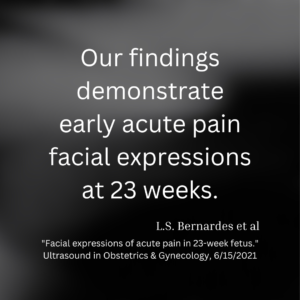Three keys to fetal pain – Part 2: Ultrasound studies
The way I see it, there are three keys to fetal pain.
- The IASP’s revised definition of pain,
- 4D ultrasound studies of fetal behavior, and
- The diminution of cortical necessity.
Last time, I discussed the International Association of the Study of Pain (IASP)’s revised definition of pain, which discarded the requirement that a patient describe her pain verbally in order for us to agree she hurts.
This time, I’ll examine key #2—4D ultrasound studies of fetal behavior that show fetal planning and even pain from the earliest gestations studied—14 to 23 weeks, before the supposed consciousness barriers of 24 weeks (or never), 28 weeks, or 29-30 weeks.
Behavior: Window Into the Mind
We can tell when another human is in pain. Generally, fighters know when they’ve hurt their opponents. Anesthesiologists know when their patients can feel the surgeon’s scalpel. Lovers know when they’ve gone too far—or, perhaps, not far enough. Veterinarians and pet owners know when their animals are hurting, and parents know when their babies are screaming in agony.
And today, by the same standard, we can tell when a human fetus is in pain.
How? Observations of behavior.
Verbal description is only one of several behaviors to express pain; inability to communicate does not negate the possibility that a human or non-human animal experiences pain.
IASP
Verbal description is now “only one of several behaviors to express pain.”
In other words, behavior is communication. The IASP’s updated definition of pain allows us to consider animal and nonverbal human pain, including fetal pain, based on observed behavior.
This inference-from-behavior is what I suspect most of us were doing instinctively with our pets and babies anyway, and it’s what Charles Darwin described 151 years ago in The Expression of the Emotions in Man and Animals (1872).
This kind of observation is the basis of science. Darwin’s observations of behavior and morphology led him to publish On the Origin of Species in 1859. At a basic level, these kinds of observations help us determine if an organism is male or female, dead or alive, dangerous or benign, annoyed or enamored.
In fact, observed behavior is the only way we can know another person. We cannot love or hate a person’s true self—only his behavior, from which we deduce his perspective.
Psychologists call this inference “Theory of Mind,” akin to empathy. Most of us employ it instinctively and sometimes even obsess about it: “Does he like me?” “Why is she acting like that?”
Until the late 20th century, it was hard to apply these observations to the human fetus, ensconced in murky mystery within her mother’s womb. The best we could do was a behavioral assessment of fetal life called “quickening” (coming to life), in which the mother felt her prenatal baby’s kick and inferred the child lived.
This barrier to observation began to fall with the advent of obstetric ultrasound, first employed around 1956 but not widely used until the 1980s. The advent of 4D ultrasound in the 1990s revealed the fetus with striking clarity, leading to a spike in studies of fetal behavior, which scientists correlated with fetal brain development and psychology.
By the 1980s, Italian psychiatrist Alessandra Piontelli (following in the footsteps of Heinz Prechtl, founder of developmental neurology) was conducting grainy, low-resolution ultrasound observations of humans in utero, finding that human psycho-behavioral tendencies were broadly consistent before and after birth.
Today, it’s possible to conduct psycho-behavioral studies on fetuses similar to those conducted on animals by the pioneers of ethology (broadly, animal psychology), Konrad Lorenz, Nikolaas Tinbergen and Karl von Frisch.
4D ultrasound-based studies of fetal behavior—for example, those by Zoia (2007), Castiello (2010), Parma (2017), and Bernardes (2021, 2022)—show “surprisingly advanced” motor planning from as early as 14 weeks and “pain” from 23 weeks, the earliest fetuses studied.
Zoia and colleagues (2007) conducted kinematic studies of fetal movements, finding “a surprisingly advanced level of motor planning” at 22 weeks’ gestation.
“Arm movements in the foetus are more coordinated and complex than previously thought,” the researchers mused, concluding that “The psychomotor ability of the fetus [may] have been underestimated.”
Castiello and colleagues (2010) found that twins interact socially from as early as 14 weeks, demonstrating not only calibrated movements directed towards the self and uterine wall, “But also movements specifically aimed at the co-twin.”
To the researchers, these behaviors suggested social awareness and, once again, “a surprisingly advanced level of motor planning” even at 14 weeks’ gestation.
Reflexes vs Consciousness
But couldn’t these actions simply be reflexes?
No. In their introductory discussion, the researchers noted that “The motor behavior of foetuses has traditionally been described in terms of reflexes rather than actions,” but they were skeptical:
Although reflexes serve important functions, they are stereotyped, elicited and once launched run their predetermined course. This signifies, for instance, that reflexes are not goal directed, are not subject to learning and do not adjust to future states in a prospective fashion [italics mine].
Castiello, et al (2010)
Motor planning and social awareness in these 14-week fetuses, then, clearly represent something beyond reflex: consciousness.
Likewise, Parma and colleagues (2017) studied the prenatal development of left- and right-handedness, finding the ratio of right- and left-hand dominance in fetuses matched that of the general population from as early as 18 weeks’ gestation.
The team discussed their findings in terms fetal preference, motives, goal-direction, and motor planning—terms consistent with consciousness, not simply reflex.
Notably, Parma’s finding of consistent hand-dominance from 18 weeks coincides with Piontelli’s observations of psychological continuity between fetuses and postnatal children—and even Sigmund Freud’s assertion that
“There is much more continuity between intra-uterine life and earliest infancy than the impressive caesura of the act of birth would have us believe.”
Sigmund Freud (Inhibitions, Symptoms and Anxiety, 1926)
If behavior is indeed consistent between fetal and neonatal life, we might expect that common, multivariate behavioral assessments of pain could apply to fetuses, not just neonates.
Bernardes and colleagues (2021) thought so, too. Thanks to high-resolution, real-time imagery available through modern 4D ultrasound, they were able to apply the standard Neonatal Facial Coding System (NFCS) to their observations of 31-week fetuses, an age at which fetuses are widely considered pain-capable. Using the NFCS, the researchers clearly differentiated between nondescript salient responses and actual expressions of “pain,” “startle,” and “rest.”
From that study, here is a video of a 31-week fetus reacting to an injection of anesthetic into his or her thigh.
In 2021, having validated these techniques on a fetus at known pain-capable gestation, Bernardes and colleagues likewise observed “early acute pain facial expressions” in a 23-week fetus receiving anesthetic injections in the left thigh. Under “Supporting Information,” the study displays a video of the 23-week fetus responding to the injection with pain behaviors.

Crucially, all of these scientists describe consciousness—motor planning, intent, goal direction, pain response—before what I call the “consciousness barrier” at 24 weeks, 28 weeks, or 29 to 30 weeks’ gestation, the authoritative lower limits proposed by the Royal College of Obstetricians and Gynaecologists (2010, 2022) and Lee and colleagues (2005).
How did they arrive at these dates for the consciousness barrier? By focusing on neurologic connections to the cerebral cortex, the part of the brain they presume necessary for consciousness, including the perception of pain.
I call this idea “cortical necessity,” and I’ll discuss its diminishing status next time.



